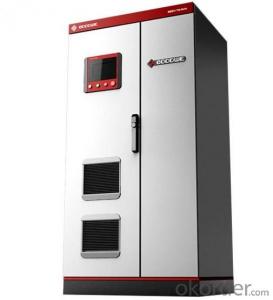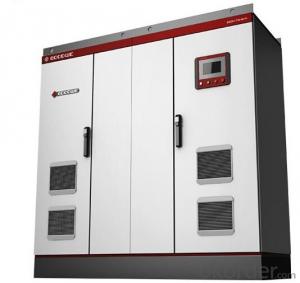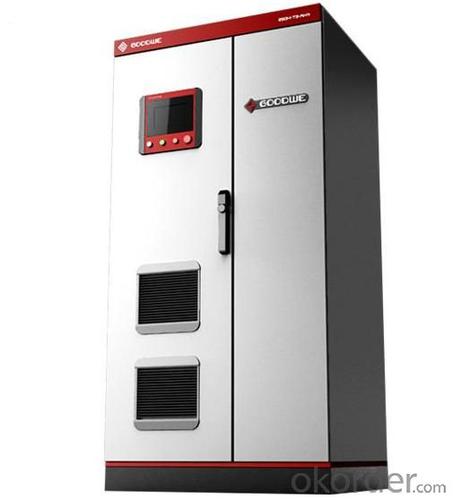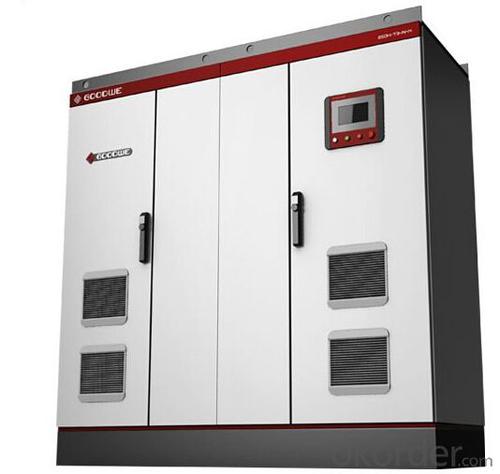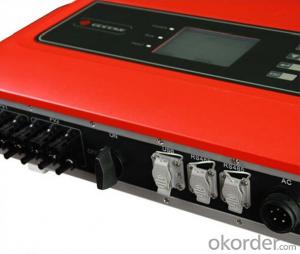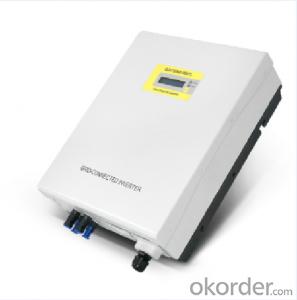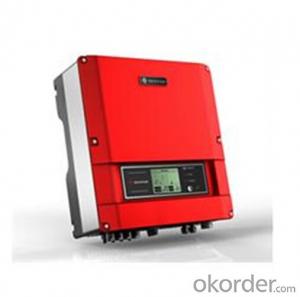12V Solar Inverter GW500K-MTL On Grid Solar Inverter
OKorder Service Pledge
OKorder Financial Service
You Might Also Like
Central solar inverter GW500K-MTL solar inverter is widely used in large-scale solar power plants. As core equipment in solar power station, its stability and reliability play an important role in long-term investment returns. GW500K-MTL solar inverter adopts industrial design philosophy as well as proven inverter control technology, which ensures its 25 years life time. In terms of solar plants grid integration, GoodWe solar inverter is also equipped with output power liner control, SVG reactive power compensation technology, LVRT capability and other advanced technologies which are apt to grid integration and management. In addition, its lower THDi output and higher conversion efficiency provide stronger support to green and efficient power plants operation.
Datasheet
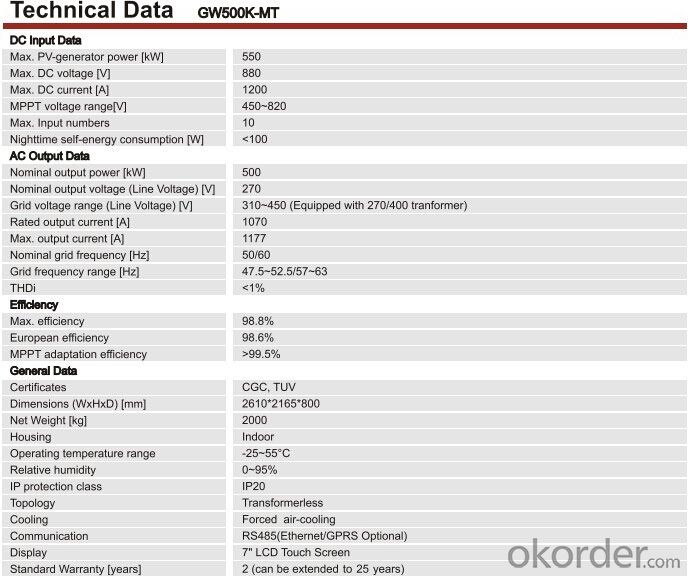
- Q: How does a solar inverter handle voltage drop in long cable runs?
- A solar inverter compensates for voltage drop in long cable runs by using a technology called Maximum Power Point Tracking (MPPT). MPPT allows the inverter to continuously adjust the operating voltage and current to extract the maximum power from the solar panels. This ensures that even with voltage drop in long cable runs, the inverter optimizes the power output from the panels, ultimately minimizing the impact of the voltage drop.
- Q: Can a solar inverter be used in areas with high levels of lightning activity?
- Yes, a solar inverter can be used in areas with high levels of lightning activity. However, it is important to ensure that the inverter is designed to withstand lightning strikes and has appropriate surge protection measures in place to prevent damage. Additionally, proper grounding and installation by a qualified professional are crucial to mitigate any potential risks associated with lightning strikes.
- Q: What is the role of frequency support in a solar inverter?
- The role of frequency support in a solar inverter is to maintain a stable and consistent frequency of the electricity being generated by the solar panels. This is important because the frequency of the electricity needs to match the frequency of the grid in order to ensure smooth and reliable power transmission. The solar inverter constantly monitors the frequency of the grid and adjusts the output of the solar panels to match it, helping to stabilize the overall grid frequency and maintain the integrity of the electrical system.
- Q: How does a solar inverter handle reactive power compensation?
- A solar inverter handles reactive power compensation by utilizing reactive power control techniques. It can dynamically regulate the amount of reactive power injected into or absorbed from the electrical grid. This helps maintain the power factor at the desired level, improving system efficiency and reducing grid instability caused by reactive power fluctuations.
- Q: What is the role of a solar inverter in protecting the electrical grid?
- The role of a solar inverter in protecting the electrical grid is to efficiently convert the direct current (DC) generated by solar panels into alternating current (AC) that can be safely integrated and synchronized with the existing grid. This helps ensure the stability, reliability, and quality of the electricity being fed into the grid, preventing any potential disruptions or damages that could occur due to inconsistent or incompatible power inputs. Additionally, solar inverters also play a crucial role in monitoring and controlling the energy flow, protecting against grid faults, and providing necessary safety features like voltage regulation and anti-islanding to safeguard both the grid and the solar installation.
- Q: Can a solar inverter be used in regions with high altitude conditions?
- Yes, a solar inverter can be used in regions with high altitude conditions. However, it is important to consider certain factors such as temperature variations, reduced air density, and increased UV radiation at higher altitudes. In such cases, it may be necessary to choose a solar inverter specifically designed to handle these conditions and ensure proper functioning and efficiency of the system.
- Q: How does a solar inverter handle shading or partial obstruction of solar panels?
- A solar inverter typically handles shading or partial obstruction of solar panels through the use of Maximum Power Point Tracking (MPPT) technology. This technology allows the inverter to optimize the power output of the panels by constantly adjusting their operating point to the maximum power available. When shading or obstruction occurs, the inverter automatically adjusts the operating voltage and current of the panels to minimize the impact and maximize the overall energy yield.
- Q: What is the role of a solar inverter in reactive power compensation during grid disturbances?
- The role of a solar inverter in reactive power compensation during grid disturbances is to regulate and stabilize the flow of reactive power between the solar PV system and the grid. During grid disturbances, such as voltage fluctuations or power factor variations, the solar inverter can actively inject or absorb reactive power to maintain the voltage and power factor within acceptable limits. This helps in improving the overall stability and reliability of the grid system, ensuring efficient power transfer, and minimizing any adverse effects on the grid and connected electrical devices.
- Q: What is the role of a solar inverter in a battery storage system?
- The role of a solar inverter in a battery storage system is to convert the direct current (DC) electricity produced by the solar panels into alternating current (AC) electricity, which is compatible with the electrical grid and can be used to power household appliances or feed back into the grid. Additionally, the solar inverter manages the charging and discharging of the batteries, ensuring efficient energy storage and usage.
- Q: Are there any government incentives available for solar inverters?
- Yes, there are government incentives available for solar inverters. These incentives vary by country and region, but often include tax credits, grants, and rebates to encourage the adoption of solar energy. It is recommended to check with local authorities or consult a solar energy professional to determine the specific incentives available in a particular area.
Send your message to us
12V Solar Inverter GW500K-MTL On Grid Solar Inverter
OKorder Service Pledge
OKorder Financial Service
Similar products
Hot products
Hot Searches
Related keywords
